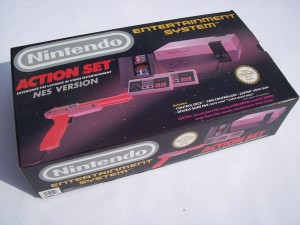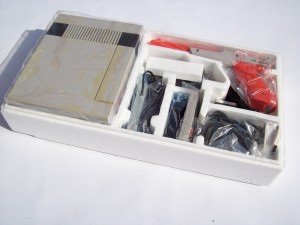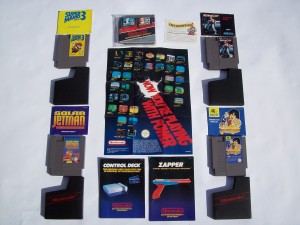The Nintendo Entertain ment System or NES as it was also known was a cartridge based console that graced our stores in 1985. Later the NES was released in the US where its name was changed to Famicom (Family Computer) as Nintendo though it would suit the market better in the US.
ment System or NES as it was also known was a cartridge based console that graced our stores in 1985. Later the NES was released in the US where its name was changed to Famicom (Family Computer) as Nintendo though it would suit the market better in the US.
The NES system was welcomed by many as it helped revive the market after the video gaming crash of 1983. The system was to also set the standard for subsequent game consoles, from hand control layout through to game design. The NES was quite powerful featuring a custom made 8-bit 6502 processor and a Picture Processing Unit (PPU). What helped was that these were developed and manufactured at low cost by a company called Ricoh.
Having an available colour palette of 48 colors and 5 grays. Red, green and blue could be individually darkened at specific screen regions using carefully timed code. Up to 24 colors could be used on one scan line: a background color, four sets of three tile colors and four sets of three sprite colors.
The system could handle up to 64 sprites with up to eight sprites being present on one scanline. With a resolution display of 256 horizontal pixels by 240 vertical pixels. Typically, games designed for NTSC-based systems had an effective resolution of only 256 by 224 pixels, as the top and bottom 8 scanlines are not visable on most television sets.
The sound for the NES came from an on-board sound chip giving a total of five sound channels. These included two pulse wave channels of variable duty cycle (12.5%, 25%, 50% and 75%), sixteen volume levels and hardware pitch bending supporting frequencies ranging from 54 Hz to 28 kHz.
Additional channels included one fixed-volume triangle wave channel supporting frequencies from 27 Hz to 56 kHz, one sixteen-volume level white noise channel supporting two modes (by adjusting inputs on a linear feedback shift registe r) at sixteen pre-programmed frequencies and one differential pulse-code modulation (DPCM) channel with six bits of range, using 1-bit delta encoding at sixteen pre-programmed sample rates from 4.2 kHz to 33.5 kHz.
r) at sixteen pre-programmed frequencies and one differential pulse-code modulation (DPCM) channel with six bits of range, using 1-bit delta encoding at sixteen pre-programmed sample rates from 4.2 kHz to 33.5 kHz.
This final channel was also capable of playing standard pulse-code modulation (PCM) sound by writing individual 7-bit values at timed intervals.
A fantastic array of games were released for the NES some being from franchises that were owned by Niniendo. Games such as the adventure series which featured titles like The Legend of Zelda, Zelda II – The Legend of Link, Super Mario Bros and Metroid. There were also great sports series with titles such as Rad Racer, R.C. Pro-Am, Ice Hockey, Pro Wrestling and Golf.
Between 1985 & 1987, thirty or so titles were made for the NES known as ‘Black Box Games’ and these are getting pretty rare. Some of these titles can start from £10.00 and reach as much as £100.00.
Some consoles were repackaged and sold in various sets i.e The Action set. This came with a NES zapper and two cartridges, Super Mario & Duckhunt. To support some games, controllers were produced such as:-
- NES Zapper – A form of light gun
- Power Pad – is a floor mat game controller. Games using the Power Pad often test players on their timing and coordination, memory, “running” speed, or allow them to play music with their steps.
- LaserScope – This was not an actual gun, but instead was a headset with a microphone and a laser-guided cross-hair that covered one eye. The Laser-Scope was powered through the audio port of the NES, which enabled the user to hear the game audio as well. All a user was required to do was say “fire” and the gun supposedly, would fire at the target.
- Vaus – also known as the Arkanoid controller.
- Power Glove – which was the first peripheral interface controller to recreate human hand movements on a television or computer screen in real time.
- R.O.B. – Robotic Operating Buddy.
Some of the titles were to become unbelievably successful with titles like Super Mario Bros 3 selling over 7 million copies of the game and making over $500 million dollars in just the US alone. This is a record that has not yet been beat and has made it the best selling game of all time ! ! !
Here is the first us television commercial shown in the US just for a bit of NES nostalgia, enjoy. . .
The only flaw i disliked with the NES was that it was made from an inferior plastic. The plastic contained an additive (bromine) that was intended to keep the casing from catching fire if the system go hot but the problem was that the additive used, caused the light gray console plastic (including the controllers) to gradually fade towards a yellow colour and also make it brittle. This was caused by it being exposed to UV-rays over a long period of time. The only way to get rid of the yellowing color is to use a hydrogen peroxide solution.
To briefly sum up the Nintendo Entertainment System, it is now as it was then a fantastic console. Nintendo could not have released the system at a better time and having sold over 19 million units, i really do think the figures speak for themselves. . .